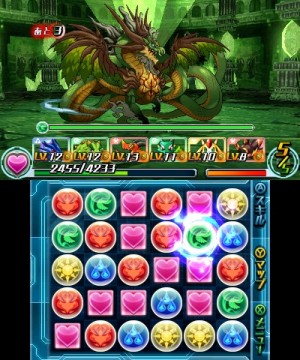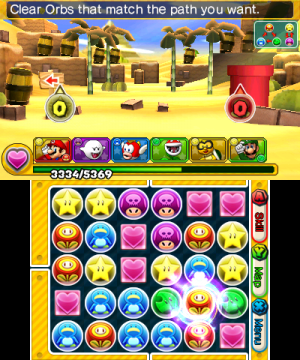Awesome concept and gameplay; Addictive mix of RPG and puzzle elements; Solid presentation for both titles; Tons of content
Puzzle & Dragons Z has a middling narrative that kills momentum more than anything else
Puzzle & Dragons began life as a free-to-play mobile game, quickly garnering a devout following and establishing itself in a very saturated market of match-three puzzle titles. Similar to Puzzle Quest before it, Puzzle & Dragons is a mixture of puzzle and RPG gameplay, ostensibly replacing traditional turn-based combat with Bejeweled or Candy Crush-like tile swapping. Match-three gameplay alone might not sound like enough to replace spell casting and weapon crafting, but developer Gung Ho Online Entertainment largely avoided a potentially major pitfall by imbuing Puzzle & Dragons with a huge dose of strategy and depth. The playing field is comprised of colored orbs (each tied to one of six elements) that must be matched in sets of three or more. Unlike many similar puzzle games, moving an orb across the field will cause passing orbs to be displaced, as well. Coupled with the limited time in which an orb can be manipulated, and the player has to carefully maneuver in order to maximize the number of combos that can be chained together. As a result, matchmaking is a mixture of player skill and luck that is ultimately very satisfying.
Further distinguishing Puzzle & Dragons is its monster collecting and evolving. The game is as much about dungeon crawling as it is hoarding a variety of dragons/beasts to nurture and assemble into a battle party. Each monster has an elemental strength (fire, water, wood, etc.) that defines it, with some elements naturally proving more powerful or weak against another. This rock-paper-scissors dynamic is exploited through orb matching; if an enemy monster is weak to fire, chain together some water orbs and all corresponding members on the player’s team will attack it in tandem. Chaining orb sets, regardless of type, boosts all attacks, so it’s beneficial to link as many orbs of as many types as possible in order to shoot for ridiculously large combos that deliver devastating amounts of damage. For Pokémon veterans, some of this setup will sound familiar, but there’s enough difference between it and Puzzle & Dragons that, despite being clearly derivative, it holds its own and never feels like a half-hearted ripoff… at least from a gameplay standpoint (more on that in a bit).

So that’s all well and good, but what about Puzzle & Dragons Z + Puzzle & Dragons: Super Mario Bros. Edition? Well, the dual games take everything that’s great about the mobile title and amplify it. Mario Bros. Edition is recommended for beginners for good reason, as it’s less challenging overall and is more streamlined than Z. The basics of gameplay are doled out at a perfect pace, and the simple narrative (Peach has been captured! Save her!) means players are able to focus on orb-switching and team building. To be clear, though, while Mario Bros. Edition is indeed less challenging, don’t mistake that to mean it’s not challenging. The game is presented as a traditional Super Mario Bros. map made up of worlds broken into individual stages. The first level is fairly straightforward, but moving beyond it players will quickly find themselves taxed to build well-rounded teams and work hard to create effective combos. Luckily, Gung Ho lets players ease into the tougher fights, but don’t expect a cake walk.
P&D Z, on the other hand, is significantly different than Mario Bros. Edition. In this game, the Pokémon similarities kick into overdrive, with players given control over a young boy who embarks on a quest to become a dragon tamer and battle the evil organization Paradox. Seriously, anyone who’s played a Pokémon game as far back as Red and Blue on Game Boy won’t be able to stop themselves from recognizing the various hallmarks of that series from which P&D Z liberally appropriates. While riffing on Pokémon isn’t the greatest sin in the world, it’s hard to peg down how I felt about P&D Z‘s storyline. It’s funny in places, but it’s also not particularly memorable. That said, it almost feels like the game’s narrative is intentionally not trying very hard, as it comes across as being fairly self-aware and even has a little fun poking at its own goofiness. I can appreciate that on a certain level, but it comes at the expense of momentum, sadly. There are breaks in the action at the end of every dungeon where story is inserted, and the game also requires backtracking to the main character’s team headquarters to crack open eggs to reveal new allies, as well as power them up. It certainly is a more fleshed out experience than the mobile Puzzle & Dragons‘ spartan screens of menus and prompts, but overall I feel like P&D Z is a mixed bag of results. Its gameplay is fun and engrossing, but its storyline is uneven and questionably implemented, not to mention too reliant on borrowing from Game Freak’s standard narrative beats.

As far as presentation goes, both titles look great. Mario Bros. Edition takes ample advantage of being allowed to play in the plumber’s sandbox, with a ton of characters and settings pulled from across a wide spectrum of the series’ numerous titles. It also incorporates a wide range of tunes and sound effects from those games, too, resulting in a smorgasbord of Super Mario fan service that certainly delighted this reviewer to no end. I’d genuinely love to see Gung Ho get a crack at another Nintendo franchise with Puzzle & Dragons at its core, as the developer made some great decisions with this inaugural effort. Maybe that “Z” can stand for Zelda in the future…? Speaking of P&D Z, it too is bold and vibrant visually, with some admirable use of 3D incorporated into its simple cinematics. The overall art direction is anime-inspired, but like the storyline doesn’t attempt to do anything players haven’t seen before. Unfortunately, the soundtrack is underwhelming, with no really catchy or memorable tunes on hand. Some of the sound effects are solid, but audio is the weakest aspect of P&D Z. Regardless, it’s a handsome companion to Mario Bros. Edition, and the two titles really compliment one another because of their marked differences– hopping between the two kept things fresh during my playthrough.
Gung Ho has done a truly admirable job introducing Puzzle & Dragons to non-mobile players. I actually went and downloaded the original after playing these two games just to get an even broader understanding of the series, and I can honestly say that Puzzle & Dragons Z + Puzzle & Dragons: Super Mario Bros. Edition perfectly replicate and evolve the core concept into something bigger and better. Removing the micro transactions and letting players focus on the pure, unadulterated fun of P&D’s unique play mechanics makes this 3DS iteration the only way to go. Though P&D Z feels disjointed in some ways, it and Mario Bros. Edition are both wonderful titles that easily could be their own separate games; having both on a single cartridge is a real gift, and one that I hope everyone decides to reward themselves with. I also hope Gung Ho switches its focus to handhelds in the future, or even better, a Wii U installment.




 ShareThis
ShareThis






